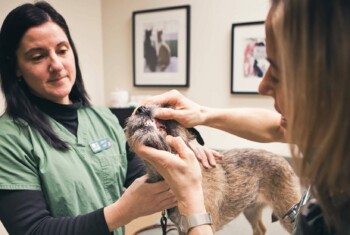Veterinarians warn dogs are also at risk for Lyme disease.
It is peak tick season in many parts of the U.S., and experts are warning that this could be an especially plentiful year for the potentially disease-carrying bugs. While Lyme disease is the most common vector borne disease in the U.S. with 476,000 people are diagnosed each year, what many people do not know, is dogs are also at risk for Lyme disease.
If left untreated, dogs with Lyme disease can experience heart complications, joint disease, and permanent nervous system damage. As dog owners take to parks and the woods this summer, BluePearl Specialty and Emergency Pet Hospital is urging owners to take a moment to brush up on the basics of Lyme disease in pets and how to prevent it.
Lyme disease, just like many other tickborne infections, is strongly regional dependent throughout the country,” explained Kristopher S. Sharpe, DVM, DACVIM, Board Certified in Veterinary Internal Medicine, Medical Director, Grand Rapids, BluePearl Pet Hospital. “One difficult thing with Lyme disease is that testing primarily shows exposure but does not prove active infection so many dogs may be exposed, and their body fights off the infection and they do not get sick.”
Here is what pet owners should know about Lyme disease and dogs.
Can dogs get Lyme disease from ticks?
Dogs, and rarely cats, can get several different infections including Lyme disease that are transmitted by ticks. Infections are regionally different throughout the country based on geographical changes and the type of tick present to transmit the disease.
What is Lyme disease?
Lyme disease is an infection caused by the bacteria borrelia burgdorferi. Borrelia is transmitted by Ixodes ticks after attachment to the animal for a minimum of 24-48 hrs. Exposure usually occurs several months after exposure to the infected tick.
What are the signs that a dog is developing Lyme?
Most dogs exposed to Lyme disease are able to fight off the infection themselves and do not develop clinical illness. In fact, clinical signs of Lyme disease are observed only in approximately 5-15% of infected canine cases. The most common clinical signs associated with Lyme disease infection include mild fever, lethargy, mild lymph node enlargement, joint swelling (arthritis in one or multiple joints), lameness (limping or abnormal walking/running behavior), and discomfort. Rarely dogs can develop a serious form of kidney disease that results in increased drinking, urinating, and decreased appetite.
How to treat Lyme disease in dogs
Lyme disease is treated with a longer course of an antibiotic, usually doxycycline. Dogs with common signs of Lyme disease usually respond to treatment within days and antibiotics are continued for up to a total of 28 days. Dogs with the rare kidney form of disease require aggressive treatment and prognosis is guarded.
How to prevent dogs from getting Lyme disease or other tick-borne illnesses
- Inspect your dog. After walks through the woods or grassy settings, be sure to thoroughly check your dog. Take a careful look between toes, under the tail, and around their mouth, eyes, and ears (do not forget the inside of the ears).
- Remove ticks immediately. Learn best practices for tick removal. The faster you find and remove a tick, the less likely it is that your dog will contract a secondary illness related to tick bites. To avoid tearing the tick and spreading possible infections into the bite area, use fine-point tweezers. Pull straight upward, in a slow and steady motion to prevent the tick’s mouth from breaking off and remaining embedded in your pet’s skin. If you are unable to do remove the tick yourself, consult with your veterinarian.
- Use flea and tick preventives. You may be able to prevent ticks from jumping on your dog and embedding within their skin by using a veterinary-approved flea and tick preventative. Consult with your veterinarian about the most appropriate product for your dog.
- Keep grass as short as possible and stay on paths. Refrain from walking into grassy patches, if possible. If hiking in the woods, try to stay on hike paths, away from high growth vegetation.
- Get your dog vaccinated for Lyme disease. Vaccination could prevent your dog from getting Lyme disease; however, the vaccine may not be appropriate for some dogs. Discuss the vaccine with your veterinarian to see what is possible for your pet.


